Pros
Cons
Introduction
Setup / Drivers and Software
Manual /Quick Start Guide (8.00)
The Easy Setup Instructions (large folding page) clearly explain the setup process. The Quick Start guide is a 102-page booklet of abbreviated instructions in one language: English. Canon only ships instructions with printers in the main language of the country where the units are sold, unlike many other printer manufacturers which usually provide multiple languages. The User’s Guide itself is loaded onto your system via the CD. This is the more helpful resource. The guide anticipates many questions and common tasks are explained clearly with the use of screen shots and diagrams. The Help and Instructions buttons, which are accessed through dialogue windows within the driver and programs, provide links to the Guide.
Out of the Box (7.00)
The Canon MP600 Multifunction printer unit comes with a removable paper cassette, five standard ink cartridges, print head, power cord, Easy Setup instructions, Installation CD (includes drivers, software, and User’s Guide), and Quick Start guide. The guide is more of a manual at 102 pages (one language) and doesn’t repeat the Easy Setup instructions, which is both a good and a bad thing. It’s nice that they’re not redundant, but if you lose or throw away the instructions, it would be good to have the information included with the Quick Start guide for future setup. As with most printers, the unit does not come with the required USB 2.0 cable necessary to connect the printer to the PC. But these aren't that expensive so you can pick one up for less than $10. Just don't forget to get one as you won't be able to print from your PC without it.
Setup (6.00)
Overall, the MP600 was easy to set up. Other than inserting the print head and the ink cartridges, there are no parts to assemble. The print head—basically a plastic tray for the cartridges—is included in a small plastic pouch. This pops into the printer carriage followed by the five cartridges—cyan, magenta, yellow, photo black, and document black—which easily slip into the head and lock in place. Small LEDs on the cartridges light up when the cartridges are correctly in place.
The menu on the unit’s LCD screen prompts the user to perform the head alignment, which simply involves loading a sheet of 8.5" x 11" paper and pressing the "OK" button. The printer handles the alignment from there.
Canon’s instructions say driver and software installation takes 10 to 20 minutes. On our test system, the actual setup time fell right within that estimate, at 17 minutes. After inserting the CD, the setup window launched with Easy Install and Custom Install options. Custom allows the Adobe RGB color space to be installed.
One minor glitch to note: Once installation was complete, the program needed to restart to accept changes, then it said the drivers couldn’t be installed because the installation utility was open. I had to back out of the utility in order to restart the system. Once it was restarted, the drivers and all the programs were installed.
Drivers & Administration (8.00)
The printer is controlled through the Canon My Printer software. The main menu options are Printer Settings, Paper Source Settings, Printer Status, and Troubleshooting. There is a lot of utility and functionality in the Printer Settings menu. Plenty of options are provided to set paper type, source, print quality, etc. The print settings and image editing options are outlined in detail in the Print Quality and Image Editing sections of the Print Settings/Options page.
Printing profiles can be managed and added to within the Profiles tab, which provides an explorer-type window with a list of profiles on the left and the settings on the right. These are simply settings made for particular jobs within the My Printer driver that can be saved for easy access. Actual printer profiles created with third-party color management software have to be loaded in the Printer dialog box of the computer’s control panel. Any new profiles added there can be set as the default profile.
The Maintenance tab offers five different maintenance functions, including cleaning, head alignment, nozzle check, and bottom plate cleaning. The pigment black cartridge can be cleaned separately from the others. The Power Off button allows the user to turn the power of the printer off (but not on, unfortunately) remotely. A Quiet Mode reduces the noise the printer makes (not entirely necessary with such a quiet printer to begin with) and also lets you set the printer to quiet down between specified hours.
The Customs Settings function allows you to change the Ink Drying Wait Time. Lowering the time speeds up printing, while increasing the time slows down printing. This seems to have to do with the amount of time the print is running through the printer. Canon states that this feature is less necessary with Canon papers as it may be with other papers, since the Canon stock has a micro-porous surface which is dry to the touch right out of the printer.
Back in the My Printer window, the second selection is Paper Source Settings. The MP600 has three paper feed settings. The unit can be set to take frequently used paper from the cassette and special papers from the auto-sheet feeder. The second option is to have the printer take paper from both trays, feeding from one until the paper runs out then feeding from the other (this is useful when printing large jobs). The printer can also be set to take paper based on the settings of the paper feed switch on the unit, which requires the user to press the button to switch between feeding locations. It’s very useful to have this option to quickly override any settings made in My Printer.
Printer Status, again from the My Printer dialog, provides basic information about what functions the printer is performing and ink status. (You can also check on the Printer Status from the main window.) The fourth option from My Printer allows access to a Troubleshooting menu. This is a basic, most-common-problems utility, with a written but not clickable link to Canon’s tech support web page. This is where most users will go with a problem since the Troubleshooting menu is not very helpful. The better reference is in the MP600 On-Screen Manual.
Software (8.00)
The software for the Canon Pixma MP600 has Canon’s typical bright design with large buttons. Other than the My Printer admin software, the applications included are Easy Photo Print, MP Navigator 3.0 (the scanning utility), the MP600 Onscreen Manual, ScanSoft OmniPage SE 4.0, and ArcSoft PhotoStudio 5.5.
The software programs are well-organized and offer both simple and advanced options. The default settings lead the user through the various processes (printing, scanning) with simple instructions. The advanced options are not daunting since most are explained in a simple, straightforward way. The software programs don’t have the same Help and Instructions buttons included with the admin software, but the options are less complicated, so specific instructions are less necessary.
Easy Photo Print is a fairly simple program that guides the novice user sequentially through the printing process using three numbered tabs—Image selection, Paper selection, and Layout. A counter below each image indicates the number of prints, so users have to select this and remember to set it back to one if you go back to print another image from the same folder. There are also Correct/Enhance options in the Image Selection and Layout/Print tabs. Correct options include Auto and Manual settings for Red-eye correction, Face Brightener, and Face Sharpener. Enhancement includes auto and manual tools for Digital Face Smoothing and a manual tool for Blemish Remover. The tools are very coarse but produce noticeable results.
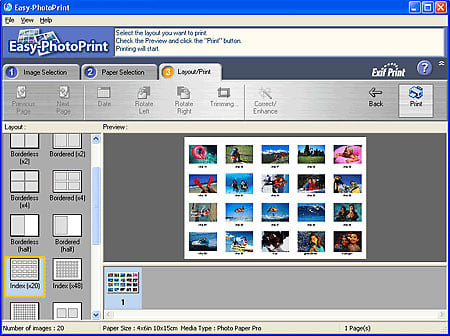
In the Paper Selection tab, the user can select Vivid Photo and Photo Noise Reduction, as in My Printer settings. Layout/Print offers the various print selections—borderless, bordered, index, etc. Users can add a date to the image and crop the image with the trimming tool, either using the rule of thirds or not.
Canon's editing functions and software programs are much easier to use and provide more options than most of their competitors, including HP and Kodak. Canon provides this utility for those who like more control over their editing without being strongly steered toward the manufacturer’s own editing technologies.
MP Navigator 3.0 is the scanning software. There are three ways to use the scan function. The most direct option is to scan from the unit itself, but this provides only basic options: Save to PC, Save as PDF file, Open with Application, and Attach to E-mail. It is not possible to change resolution, document/image type/size, etc. All of these options are only accessible through the software.
The main page of the MP Navigator 3.0 software has three main functions: Scan/Import, View and Use, and One-click. The Scan/Import function allows for scanning on the printer or importing images from a memory card. The View and Use tab is a browser to access previously scanned images. One-click allows users to set up preferences for the one-click buttons, accessed through the software or from the unit. These are helpful tools for oft-used settings, and there is also one handy, customizable one-click button (accessed only via the software) for any settings the user prefers.
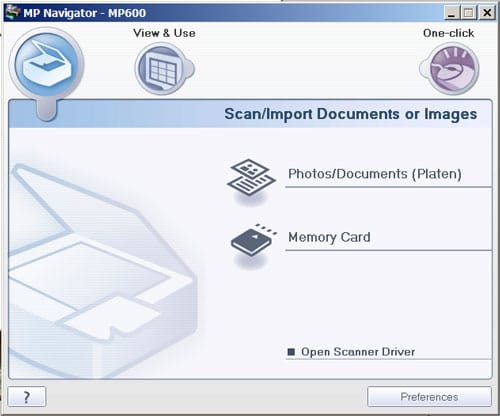
The MP Navigator uses a similar three-step approach to the printing software: Place documents, Select Document Type, and Click Scan. Some minor adjustments can be made (the default settings are color document, Auto Detect of document size, and 300 dpi). Document type, size, and resolution can be selected. Although only up to 600 dpi is available here for some reason but up to 1200 dpi is available in the scanner driver. I can only assume Canon doesn’t expect the casual user to need scans greater than 600 dpi.
The Preferences button at the bottom of the main screen leads to a pop-up window which provides settings for where the scanned file should be saved and for assigning options to the Black and Color buttons on the unit. The options that the on-printer menu provides (Scan to File, Scan to pdf, etc.), and the file location and type (BMP, TIFF, or JPG, with 3 quality settings for JPGs) can also be configured from here. Scan settings are also controlled from here, including document type, size, and resolution (75 to 600 dpi).
The Scan menu is very limited, but as mentioned in the Software and Drivers section, more options are possible with the scanner driver, ScanGear, that is accessed through the button on the lower right of the main MP Navigator screen. Scanning at the highest resolution (1200 dpi) is only possible through the driver. ScanGear is a typical scan utility, with Simple and Advanced modes. This is most useful for scanning settings that are outside the parameters assigned to the one-touch buttons. Some image adjustment tools are available, such as color, brightness, and tone curves. There is also a Multi Scan mode, which makes it easier to scan multiple photos from a single pass. You put them separately on the scanner bed. The software detects this and saves them as separate files. This is a very easy and useful function. The resulting photos are scanned and saved as separate files.
When scanning a 4"x6" print from the MP Navigator, make sure to choose Auto Detect for paper size. Or, if you choose to select the image size yourself, such as 4"x6," make sure that the orientation of the print corresponds with the orientation of the platen glass—long edge against long edge—or if the short edge is along the long edge, make sure to choose 6"x4".
ScanGear is for the slightly advanced user. Since the default settings produce decent results, this can be used as a basic printing unit. However, the extra editing functions would be useful for someone without Photoshop or other photo editing software who would like some simple controls over their final prints.

Two other bundled programs, ArcSoft PhotoStudio 5.5 and ScanSoft OmniPage SE 4.0, are included with the bundled software. ArcSoft is a stripped-down Photoshop-like program for photo editing. ScanSoft is optical character recognition software that allows scanned documents to be converted back into text.
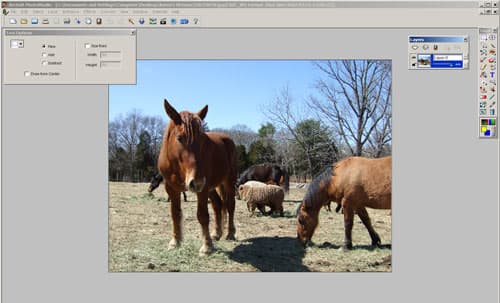
Document Performance
General Performance
**Warm-Up Time* (4.95)
The Pixma MP600 performed well for its class in both speed and quality categories. Its warm-up time of 25 seconds was quicker than some of its competitors. Equivalent models by HP and Kodak took longer to bring to achieve ready status (42 seconds and 33 seconds respectively), and with a lot more complaining. Both the HP Photosmart 5180 and the Kodak EasyShare 5300 make a lot of noise as they are warming up and calibrating themselves.The Canon MP600 makes a few minor clicks and whirrs, but it certainly doesn't sound like the HPC5180, which could easily compete with take-off time at Logan Airport.
Power Usage (7.50)
This all-in-one printer is certainly not a power hog, as our watt meter recorded, and our power readings were very much in line with Canon's reported power usage figures. We measure power usage by plugging the printer into a watt meter and note how many watts of power it uses. The Canon MP600 did not use any power when off. Some printers, like the HP Photosmart 5180, register power usage even while off. The MP600 does have an idle mode and drew 1 watt of power according to our watt meter. This is the lowest idle power draw we saw, significantly lower than the HP 3600n's 12 watts or the Kodak ES 5300's 6 watts.
The Canon MP600 drew 5 watts of power when ready. This is slightly higher than most printers we tested which fell in the 3-4 watt range. It is significantly less than the Kodak ES 5300 which drew 13 watts of power when ready. When printing, the MP600 drew 16 watts. As a reference, this number is significantly lower than the Canon CP730, a dye sublimation printer, which drew between 50 to 62 watts and slightly more than the Canon Pro9000’s 13 watts. Because self-cleaning puts the printer through a variety of processes, this number is usually a range rather than a single number. The Canon MP600 drew between 8 and 21 watts of power during self-cleaning, an average of 14.5 watts. This is slightly higher than the Canon Pro9000 (13 watt average), but it's significantly less than the Kodak ES 5300 which drew 30.5 watts on average.
Speed/Timing (4.33)
Our tested times for printing black-and-white text on the Pixma MP600 yielded a respectable pace for an inkjet printer—2.81 pages per minute (ppm), when printing from Word. These times represent testing a seven-page document at the highest quality setting. Color graphics, in the form of a PDF newsletter printed from Acrobat Reader, print at only half that output, 1.35 ppm. These test times fell in the mid-range between two other currently tested printers, the HP Photosmart 5180 and the Kodak EasyShare 5300.
Photo Performance
Speed/Timing (6.09)
The Canon Pixma MP600 photo all-in-one printer printed color photos at the 4x6-inch size print at 1.6 pages per minute (ppm) from the Easy Photo Print software bundled with the printer. Larger file sizes did not appreciably influence printing time. Printerinfo tests photo printing speeds with two different sized color images—one 5.8-megabyte file and one 18-megabyte file—at the highest quality setting the printer can handle.
The MP600’s times were about in the mid-range of the three competitors recently tested (the HP Photosmart 5180 and the Kodak EasyShare 5300 being the other two), but it performed quickest of the three at printing larger file sizes on 4x6-inch paper.
As expected, print speeds slowed considerably when printing at larger sizes. In this case, the maximum size for this printer, 8.5"x11," printed at 0.52 ppm.
Some of the slowest speeds we recorded were while printing photos from memory cards, but this seems to be an area in which all the all-in-one printers lagged. Four-by-six-inch prints printed at less than a page per minute for every test, and 8.5"x11" prints came out at the rate of 0.41 ppm for 5.7 MB files and 0.28 ppm for 17 MB files.
The MP600 also has a Quiet Mode that reduces the noise it makes when in operation. Canon does this by slowing down the carriage speed. Noise seemed to subside when this mode was turned on, but this photo all-in-one printer is very quiet to begin with. We expected print times to substantially decrease in this mode because of the carriage slowdown. Ppm scores did decrease nearly a full page per minute, to 2.11 ppm for text and 1.22 ppm for graphics, and an average decrease of 0.1 ppm for all photo times. Strangely, 8.5"x11"-sized prints printed that much quicker in quiet mode than in regular mode. This is an already slow process, so perhaps the small change introduced by the Quiet Mode was negated by the overall printing time.
Color Accuracy (3.32)
Since users' color preferences vary, we elected to evaluate color in terms of accuracy, striving for a faithful reproduction of the individual image. Accurate reproductions will enable users to tweak the colors to their desired look. To test the accuracy of each printer, we created an electronic GretagMacbeth color checker using the standard LAB values. The electronic chart was then printed with the Canon MP600 in sRGB color space. We then measured the print using an Eye-One Pro spectrophotometer and compared the values to the original, with the error recorded for each tone.
The Canon MP600 garnered a 6.48 mean color error, earning a 3.32 overall color score. Some of the tones – particularly the blues and light green seemed a bit embellished and oversaturated, though overall reproductions were more accurate than many competing models we have tested.
Color Gamut (4.59)
Our color gamut test is a measure of how much of the standard Adobe RGB color space the printer can reproduce accurately. Printers that can reproduce more of this color space ultimately show greater color potential and often provide a richer color range in images. We use the manufacturer's color profiles for given papers and compare these to the Adobe RGB color space. In the graph below, the grid represents the full Adobe RGB color space, while the solid color represents the color space that the printer can produce. The closer the two shapes, the higher the score.
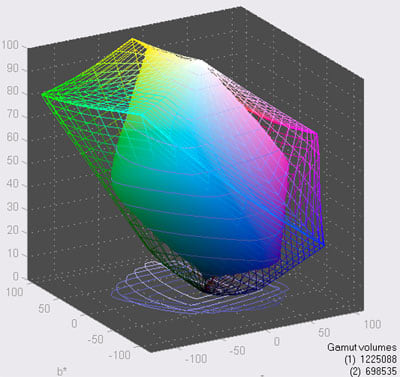
The Canon MP600 scored moderately on this test, managing to reproduce 57 percent of the color space, or 698,535 colors, using Canon's own Photo Paper Pro. Although that may not sound that impressive, it is a very good range for a printer in this class. No printer covers the entire range and those that exceed the 50 percent mark show the capability to reproduce a significant range of tones.
Dmax (5.80)
DMax, or maximum density, is a measure of the density of the blackest black a printer can produce, a very important factor in image quality because it determines the range of tones that can be produced in the print. The whitest white is set by the paper tone, so print tones can only fall between paper white and the blackest black. We evaluated DMax by measuring the ratio of light reflected off the black tone of a print. Dmax has a similar significance to dynamic range in cameras, as it defines the usable tonal range. We printed our tests on Canon’s glossy Photo Paper Pro and Ilford Galerie smooth glossy paper, and used both Canon’s stock color profiles as well as our own custom color profiles for each paper. Excellent photo printers can get up to 2.5 or so.
The Canon MP600 yielded a Dmax of 2.20, again scoring in between the other two competitively priced all-in-one printers currently in our labs. The Kodak EasyShare 5300 yielded a Dmax of 2.43, while the HP Photosmart 5180 produced a Dmax of 2.12. The Canon MP600 achieved its best Dmax value using Canon's Photo Paper Pro and the corresponding stock color profile.
Black and White (5.50)
The MP600 all-in-one produced a decent black-and-white print using our test print, with a larger tonal range than the HP C5180, but not as wide as the Kodak EasyShare 5300. These comparisons are in line with the printers' Dmax scores. There was a noticeable but not extreme loss of detail in the highlights and shadows, but for an all-in-one printer, the MP600 did a decent job.
Tour & Components
One of the highlights of the Canon Pixma MP600 is its sleek design and relatively light weight for a multifunction unit. It's also very stable on the tabletop, as the broadest surface lies flat on the table. The six small, square, rubber feet keep the unit immobile.
Tour
Front
Viewed from the front, the MP600 is a 16-inch by 6-inch rectangle of black plastic framed by silver plastic. The Canon logo is prominently displayed in the middle of the black plastic front. The paper cassette slides out from the bottom while the CF and SD/MS/SM memory card slots lie vertically behind a door to the right with a handy tab to open it with. A USB connection and an IrDA port lie below the memory card door. Two small LEDS are visible near the top center of the unit. When illuminated, the one on the right indicates that the power is on with a green light, while the one on the left indicates that the unit is working (printing/scanning/copying), with a yellow light.
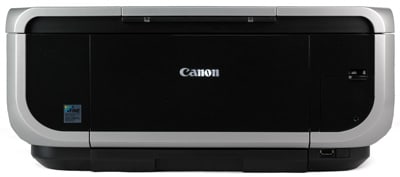
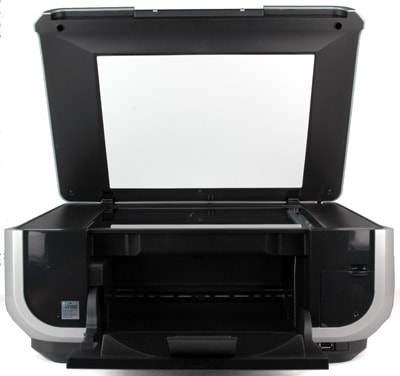
Back
The MP600’s rear cover opens to allow access for removing jammed paper from the transport unit. The paper feed tray flips open and extends upward. With both doors in closed position, the rear is compact and neat. There’s a USB port on the left side for plugging the unit into the computer with a USB cable (an accessory that's not included). Above this is the electrical cable connecting the main part of the unit with the scanner door, which contains the controls under the flip-up panel.
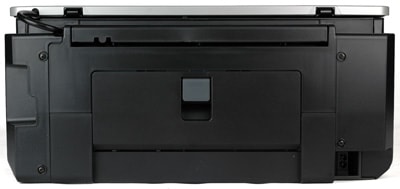
Left Side
The left side of the MP600 employs a simple design with no functional aspects. Similar to the front is the black rectangle surrounded by silver plastic that extends down from the top.
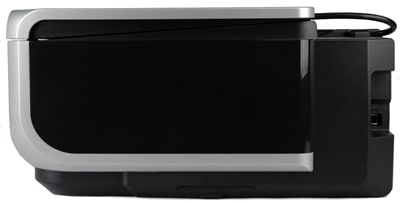
Right Side
The right side of the Pixma MP600 is nearly identical to the left side, except that the USB port is visible at the lower back.

Top
With the main and operation panel door closed, the MP600’s top is an unobtrusive silver plastic rectangle adorned only by the Pixma logo in the center. The top of the unit is actually the scanner/copier door, with the 4" x 7" operation panel door/LCD screen at the front of the unit. This door flips open to reveal the LCD screen on the inside face of the door and the control panel below that. The control panel sports a simple display, with a MP3 player-like scroll-wheel in the center. Surrounding the scroll wheel are four directional buttons that assist navigation, and in the center of the wheel is the OK button. Two long, narrow function buttons sit above the scroll wheel and their functions are indicated by the on-screen menu, mostly the Remaining ink volume item and Introduction item. Immediately to the right of the scroll wheel are plus and minus buttons to increase or decrease the number of copies ordered. To the right of those are the two Start buttons—one for Black and one for Color. The Stop/Reset button, to interrupt the job, lies conveniently above the Start buttons.

To the left of the scroll wheel, from top to bottom, are the On/Off button, the Feed Switch button (with its corresponding printer icon and LED lights to indicate which tray the printer will pull paper from first), the Navi button which opens the menu on the LCD screen, and the Home button, which brings you back to the main menu on the screen. A Back button just below and to the left of the scroll wheel is helpful if you need to back out of a menu without going Home. The black plastic rear compartment houses the rear-feed paper tray, which flips open and extends to hold paper upright.
Interior
The inside of the Pixma MP600 is accessed by opening the output tray/door in the front of the unit, then lifting the top of the unit, including the scanner bed, from the front. The interior is simple and sturdy, with black plastic surrounding most of the moving parts. A hydraulic arm on the left assists lifting and holds the printer top open to provide access to the ink cartridges and print head. When the power is on, the print head carriage moves from its seat on the left (hidden) to the open center area of the printer. A hinged guard in front of the cartridges folds down to provide easier access. Details about removal and installation of the ink cartridges and print head can be found in the Setup and Ink sections.
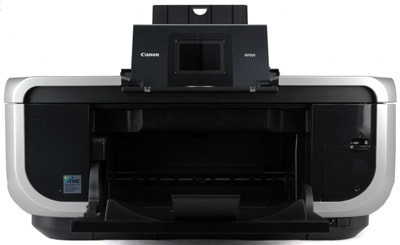
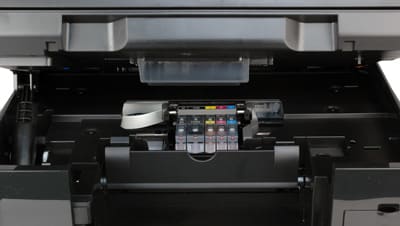
Components
Display (8.00)
Canon claims that the 2.5" TFT LCD has a 170-degree angle of view, and it is bright and very readable. Its location on the flip-up panel just above the scroll wheel keeps the control panel uncluttered and allows for intuitive interaction between the controls and the screen.
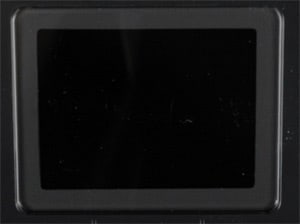
Paper Trays (8.00)
The MP600 comes with two paper feed locations. The first is a paper cassette, housed beneath the front output tray. The cassette slides in and out smoothly from its handy location beneath the printer. This keeps the paper neat, uncluttered, and away from dust and dirt. The unit also has an auto-sheet feeder—a fold-out paper carriage at the rear top, where paper can be fed manually or in a bunch. Both feeding locations have a capacity of 150 sheets of document paper. The two locations are handy when printing both photos and text. Paper feeds easily and fluidly from both trays. Duplex (double-sided) printing is possible from either tray. Roll printing options are not possible, typical with multifunction printers.
The output tray doubles as a door in the printer’s front, folding up neatly out of the way when not in use. Another nice feature is that if you’ve forgotten to open the door, it will open automatically when printing begins.

CD Burner (0)
No CD burner is included with the MP600, typical for an all-in-one printer in this price range.
Power supply

The MP600's power cord port is at the left rear of the unit. The cord itself is simply that, the cord, since the power adapter is housed within the unit.
Internal Memory (0)
The Pixma MP600 has no internal memory, which again is typical for an all-in-one printer in this class.
Multi-tasking (4.00)
The Canon MP600 cannot multi-task very well. It can store multiple jobs in the print queue, as any printer can, but only one function (copy, scan, print) can be performed at a time.
Hard Drive (0)
The Pixma MP600 does not have a hard drive included. Most all-in-one printers in this class do not have one as standard equipment.
Accessories (6.50)
Ink cartridges and the print head are standard accessories included with the Pixma MP600. Optional accessories also include a Bluetooth adapter for printing from these devices enabled with that technology. Additional inks and photo paper can be purchased from Canon’s website. Cartridges cost $14.25 each, except for the pigment black, which sells for a bit more at $16.25. The four dye colors are also available in a multi-pack for $49.99. Canon does not offer higher capacity versions of these cartridges.
Design & Interface
Controls/Buttons/Dials (8.00)
The control buttons on the PIXMA MP600 are large, clearly labeled, and easy to use. Plenty of spacing and clear graphic and text among controls allows for easy use. The Color and Black Start buttons can assign specific commands to them for the scan function from the software. This is helpful if you scan lots of the same type of documents or photos at the same settings and want them all saved to the same location.
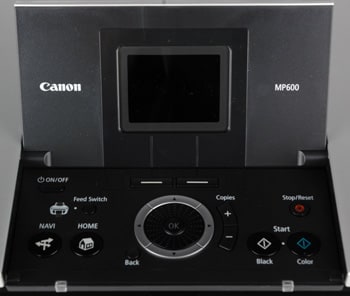
Menus (7.50)
The MP600’s on-unit menus are bright, clear, and easy to navigate, with an easily readable sans-serif font. User interface is basic, with options for each function on the main circular menu animated to the scroll wheel’s movements. Menu options include Easy photo reprint (for printing scanned photos), Memory card (with options for layout and multiple images per sheet, DPOF printing, printing EXIF data), Copy, Scan (to File, to PDF, Open to application, and Attach to e-mail), CD/DVD label print, Sheet printing (for multiple images on one sheet), and Settings. Most of the basic maintenance settings and some basic device settings can be accessed here.
The copy function includes choices for document/image size, paper type, and print quality. The settings within the menus are presented as a list, with the scroll wheel animating the list, bringing each option forward with the scroll, to be selected by the OK button. The Back button below the scroll wheel makes it easier to back out of a menu without having to hit the Home button. A nested menu design, like on MP3 players, might have been more user friendly, with the scroll wheel and buttons allowing access between and within windows. Other multifunction printers, like the HP Photosmart 5180, have different control buttons to access specific menu items—for print, copy, and scan functions— which are much less confusing than the four-way controller approach of the MP600. Also, the MP600’s LCD screen does not offer information about printer status beyond what function is being performed (e.g., Printing…, Scanning…, Copying…). More detailed information about number of pages/photos printed and to be printed would be helpful. However, the printer driver does provide this information.
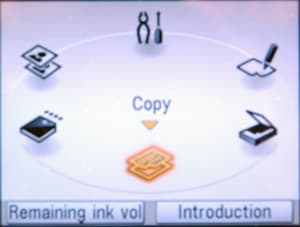
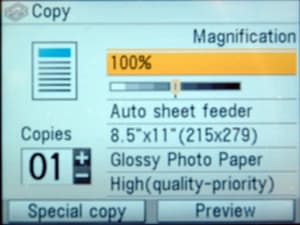

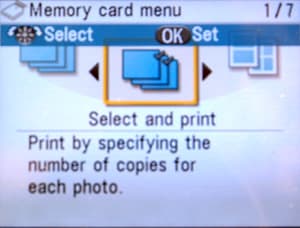
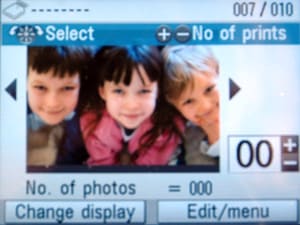
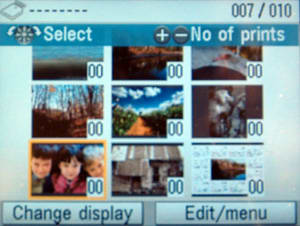

Size / Footprint (3.62)
With the scanner door and all trays and doors open, the MP600 measures 17.7" wide by 15.3" deep by 7.6" high and weighs 22.3 pounds. With all trays open, the printer measures. However, the MP600 packs up neatly, to 17.7" wide by 22.5" deep by 18" high; this compact design makes it is relatively easy to move around the desktop or from table to table.
Inks / Toner
Configuration (7.50)
Canon includes five inks with this printer. The four dye-based inks—cyan, magenta, yellow, and black, part of Canon’s ChromaLife 100 system, are used to print photos and graphics, while the large PGBK ink tank contains black pigment ink for document printing. This dedicated document black allows for crisper text and keeps the MP600 printer from using up the black photo cartridge when printing documents.
Canon's print heads are capable of some of the smallest droplet sizes in the industry, at 1 picoliter. The smaller the droplets, the more can fit in a given area of the print, yielding a higher resolution. The MP600 also features 3,584 nozzles to eject these droplets. All Pixma models above the MP600 in cost use the 1-picoliter technology.
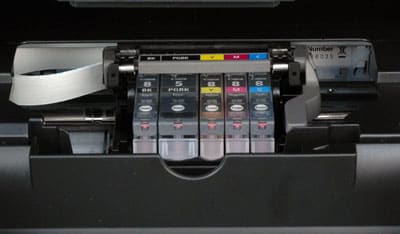
Value (7.00)
The black pigment cartridge costs $16.25 and the color cartridges cost $14.25. Canon does not report the price per print for the MP600, but the ink breaks down to a cost of $.86 per milliliter for pigment black and $1.10 for color, relatively cheap compared to other manufacturers, such as HP. Their inks for the Photosmart 5180 cost $1.80/ml for black and $2.50/ml for color.
Ink management tools (6.50)
Ink management tools are accessed via the driver software and on the unit’s main menu. If inks are low, the driver will bring up a window notifying the user, indicating which inks are low with a graphic showing ink levels. An exclamation point in a yellow circle above the ink colors that are low shows up when the inks reach the last bar of the printer menu’s graphic. While none are meant to be exact measurements of ink levels, there are three different ways that ink levels are displayed. Two methods on the unit’s menu are bars (corresponding to about five levels of inks, from empty to full) and solid fields within the ink cartridge graphic. In the printer driver, the Printer Status window shows yet again another graphic displaying solid fields.

During testing, low ink warning levels for magenta and yellow were displayed, with 3 bars, 2 bars, and finally 1 bar. At this point, the unit said it "may have run out" of magenta ink, while running a set of five 5" x 7" color prints. Pressing "OK" allowed the printing cycle to continue, with no perceptible change in quality. A subsequent run of five prints were run through, but after the last print, the low ink warning graphic was displayed on the unit, and no further printing or performance of any function, including scanning, was possible. The unit was dead in the water. If inks are on hand, this isn’t an issue, but if the user would still like to use the scan or even the black text print or copy functions, they have no recourse but to run out and buy inks.
Print Settings / Options
Print Quality (7.00)
These options are controlled through the Canon My Printer software. The main menu options are Printer Settings, Paper Source Settings, Printer Status, and Troubleshooting.
There are five main tabs in Printer Settings. The Main tab includes drop-down menus for Media Type and Paper Source. The media types include the standard fare—plain paper, photo paper (Canon’s grades as well as basic glossy, matte, and other options), high resolution, hagaki, t-shirt transfers, and envelope. A sidebar on the left side of the Main display displays text and graphics showing the selections for Media Type and Paper Source as well as for page size and orientation, which are selected on the Page Setup tab. The graphics, an icon of the printer with arrows indicating the direction of the paper movement and an icon of a printed page with blue lines indicating text, change as some of the options are changed, so you don’t have to switch between tabs to see some of your settings. While helpful for first-time users, the graphics are a waste of space once the user is familiar with the utility. A list of other basic specs, like page layout, number of copies, and profile in use would be more useful to include in the sidebar. Also, an icon of what I assume is a sheet of paper appears in the tab. This doesn’t change when media type is changed, so it truly is a waste of space.
Also on the Main tab are three basic quality settings (high, standard, and fast) and a custom option (accessed through a "Set..." button) which enables a slider bar for quality (1-5) and 3 options for half-toning—Dither (dots in fixed pattern for text and graphics), Diffusion (dots in random pattern for photos), and Auto, the default. The quality slide bar might be an intriguing tool for those who like to tweak the settings themselves, but it hardly seems necessary for documents.
The Instructions button at the bottom of any driver tab opens up the very helpful MP600 Printer Driver Guide, which includes instructions for basic printing, printing methods, adjustments to print quality, maintenance, information about the printer driver, updates, etc. Instructions are well written, and they include screen shots, diagrams, and tips. The Help button displays specific information about the functions of whichever tab that you happen to be working in, which is a nice shortcut. For example, the Help menu for the Main tab describes the options for setting the paper source. The Paper Feed Switch might not be familiar to many people, so the menu describes it clearly.
The Page Setup tab includes typical page size and orientation selections. There is also an option to have the page size be different than the printer paper size. When normal-size printing is checked in the Page Layout section, no printer paper sizes are available. The other choices, such as Fit-to-Page printing and Scaled printing, allow the printed area to be reduced or enlarged according to the printer paper size. Page layout printing allows multiple prints on the same page. Poster Printing allows images to be printed across several pages, which can then be taped together for large posters.
Duplex printing, stapling margins, and number of copies are also options found within this tab. Stamps and backgrounds can be added from a dialogue button.
Image Editing (7.50)
The Main tab of the Printer settings dialogue box features a Color/Intensity button for auto or manual control, which opens the Manual Color Adjustment window seen below. Color Correction options include a limited selection of color management systems— Driver Matching, Windows Image Color Management (with a profile selection dropdown), and None. Adjustments for Intensity, Contrast, and Brightness are also possible. For some reason, Canon provides sliders for the first two options and a drop-down for the third. The only way to preview the effects of these tools is two tiny stock images of a child at the beach; one displays the original setting and the other the preview of the settings. A tiny color scale, text examples, and 3-D color objects also serve as aids. Coarse changes are assessable, but it would not be useful for finer changes. It would be more useful to have a preview of the image to be printed. Checkboxes for grayscale printing and print preview are also on the Main tab.
Several image editing tools are available in the Effects tab. The Simulate Illustration checkbox appears to up the contrast and reduce the brightness of an image to make it pop and appear less photographic. A checkbox for Vivid Colors intensifies background colors while keeping skin tones more or less the same. On the preview, this seemed to flatten the image, reducing depth—again, an illustrative gimmick perhaps helpful when you’re working with a drab image. Three other checkboxes appear on this tab: Image Optimizer smooths out pixelated data, so it’s intended to be used for low-resolution images that need help; Photo Optimizer Pro is supposed to correct for color shifts, under- and overexposure; and Photo Noise Reduction, Normal or Strong, is intended to reduce noise from digital images.
Black and White Effects (8.00)
The MP600 allows the user to change color images to black and white or monochrome with the Monochrome Effects setting in the Effects tab of the printer driver administration software. Options include set selections (Sepia, Pink, Blue, and Green) as well as a custom color function with a slider to choose your own toning. This is anice feature not seen on many other all-in-one photo printers.
Media Types (8.00)
The Canon MP600 accepts a wide variety of paper types and sizes. Sizes include credit card (2.13 x 3.39 inches) 4 x 6, 5 x 7, 8 x 10, 8.5 x 11, and 4 x 7.1 inches when using a Canon PictBridge-enabled camera. All Canon papers are accepted, including photo stickers, as well as third party photo papers.
Connectivity
Formats / Compatibility (7.00)
PictBridge is supported, with a USB connection below the memory card door.
Media slots (8.00)
Compact Flash, SM, Memory Stick, Memory Stick Pro, SD, SDHC, and MMC v. 3.31 cards are supported. Memory Stick Duo, Memory Stick Pro, xD, and miniSD are only supported with the use of special adapters. The Memory Card slots are accessible and protected behind a door to the side of the output tray, a nice feature that other printers in this class do not have. Testing speeds were the same for Compact Flash and SDHC. Printing from the printer interface was easy. All the necessary format selections and limited editing features are possible. Reading of large image files from the memory card was slow, as when scrolling through the images to view thumbnails on the LCD screen. Printing in this mode was also slow. (See Performance section.)
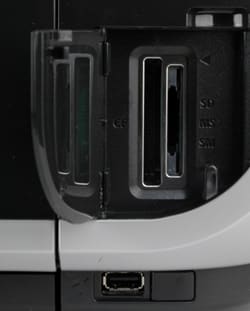
Wireless interface (6.00)
An IrDa port is provided for sending images wirelessly from cell phones and other compatible devices. Bluetooth connectivity is possible with the purchase of a special adapter, the BU-20. There is no option for WiFi wireless networking, though.
Network (0)
The MP600 is not compatible with networking.
Copy
Features (7.00)

Copying is only possible from the unit itself, but copy functions are simple enough that control from a computer is not necessary, and the copy function will work even when the computer is not turned on. The main copy menu included basic options for scale, paper size and type, print quality, and paper feed location. A "special copy" button brings up options for 2-sided, borderless, 2-on-1, 4-on-1, and Image Repeat (repeat copy on same page multiple times) copying. Printing multiple pages on a single page requires the user to manually scan the documents. A separate button for color or black-and-white copies is helpful, and it aids scanning to be able to assign different functions to each button.
Speed Timing (4.61)
Black-and-white text document copying was relatively quick for an inkjet unit, at 2.7 ppm, the fastest time this printer achieved aside from the black-and-white document printing test. Color copy times were considerably slower, 1.1 ppm. These times were much quicker than other photo all-in-ones in this same class, such as the HP Photosmart 5180.
Canon reports speeds of 30 ppm for black-and-white documents and 24 ppm for color documents. Our numbers and Canon’s numbers are not truly comparable since our test methods differ. Canon tests at the fastest print speeds and measures from when paper begins to be pulled into the printer to when the print drops into the output tray. Printerinfo measures from when Copy or Ok is clicked on the on-unit display to when the copy drops into the output tray. (See "How We Test" in the Features section for more information on our testing procedures.) Printerinfo feels that our testing procedures provide a better sense of the printer performing at its full potential. Most users will not be printing at draft settings exclusively but more commonly at standard quality or high quality settings.
Copy Color Quality (7.22)
The Canon MP600 scored quite well in our copy quality test. This test is similar to the scan quality test, in which we use Imatest’s Colorcheck program to determine the average difference between the printer’s interpreted color values and the ideal color values of the 24 colors on the Gretag Macbeth Colorchecker chart. In the copy test, we simply make a copy of the Colorchecker chart at the printer’s best quality settings. This chart is then scanned into our test computer using the Epson Perfection V700 scanner, our calibrated lab scanner. We run the resulting image file through Imatest’s Colorcheck. One of this test’s output charts is the a**b** Color Error chart show below. This graphically displays the point in the sRGB color space where the ideal value (represented by squares) for a given color lies in relation to the scanner’s interpretation of that color (represented by circles. "Camera" on this chart is actually the scanner; this test is also performed on cameras.) The average distance between all color values is the color error; in this case, we use the Delta C uncorrected error value because it takes the least amount of variables into consideration.

The MP600 error is 6.93, just a little less than the 6.97 error value that the Kodak Easyshare 5300 displayed and significantly less than the HP Photosmart 5180’s error of 8.51. The best cameras and scanners usually score around 5.0 to 5.5 in this test. As can be seen in the color error chart below the greatest error (distance of circle from square) occurs within the orange-red-magenta side of the spectrum. Many of the other values were spot on, especially the greens. Lighter skin tones (color 2) showed more error than is desirable, although darker tones (color 1) were much closer to the ideal. The MP600’s error value was actually less in the copy test than it was in the scan test. Our supposition here is that the scan is intended for monitor viewing and possible color correction in software, while the copy is intended to replicate the paper original more exactly.
The saturation value displayed by the MP600 was 8 percentage points above the ideal of 100 percent, which is still in an acceptable range and actually quite good for a copy. This value displayed more saturation than just the scan test for this printer, which may be an additive saturation value for both the scanning (the first component of copying) and the printing functions. The Kodak and the HP saturation values were below 100 percent, 94 and 96 percent, respectively, and the prints reflected this, looking flat and washed out. The MP600 print was much more vibrant and saturated-looking.
Scan
Scan Features (7.00)
The Pixma MP600 scanner’s maximum optical resolution is 2400 x 4800 dpi with an interpolated maximum resolution of 19,200 x 19,200, and it is capable of 48-bit internal color processing and 24-bit output. All of these specs are standard for a multifunction printer in this class, such as the HP Photosmart 5180.

As with other functions on the MP600, scanning is nearly soundless except for initialization and when the lamp returns to its dock. As with most scanners in this price range, it has a Contact Image sensor (CIS), which is more lightweight and requires less power than a CCD sensor, the same kind found in high-quality digital cameras. The downside of CIS sensors is greater image noise and reduced image depth. The next model up in the Pixma line, the MP800, comes with a CCD sensor, which yields better scan quality, for $120 more.
The scanning bed can accommodate an 8.5"x11.7" maximum size. The door opens easily, and the hinges hold it open above about five inches. The door still needs to be lifted and lowered carefully as the hydraulic arm can yank it out of your hand. The hinges are flexible and can extend for copying or scanning pages from books. A foam pad covered with a white plastic sheet offers protection to the recessed platen and any paper placed on the platen. The MP600 does not come with any adapters such as film holders or scanners, nor are they available as accessories. Like other multifunction units in this price category, it’s not a scanner built for that kind of quality or use.
Scanning can be performed via the on-unit menu, MP Navigator, or the printer driver (accessed through MP Navigator). The on-unit scan menu gives four options, for which options can be set within MP Navigator. Our tests were conducted via the driver, ScanGear, but the software integrates with other programs, like Adobe Photoshop.
Scan Speed (6.18)
Scanning times for the MP600 were quick for photo all-in-ones, even at higher resolutions. The text and photo test times up to 300 dpi were very quick. Only at 600 dpi and above did performance slow down appreciably. Scanning was slowest at the highest dpi, 1200. However, the MP600 still performed more quickly than other multifunction scanners we tested, such as the HP Photosmart 5180, which took twelve minutes to scan an 8.5" x 11" photo, while the MP600 took just four minutes, its longest test time along with the color document scan time. Canon doesn’t report scan times, so there’s no point of comparison possible with the manufacturer specs.
Scan Color Quality (4.76)

Color error for the Canon MP600 scanner component is represented at left on the Colorchecker a**b** color error chart, which shows the distance from the ideal for each of the chart’s 24 values displayed on the sRGB color space. The numbers alongside the circles correspond to each of the numbered chart squares above. The ideal values are displayed as squares while the scanner values (written as camera here because this test also works for cameras) are shown as circles. Skin tones—squares 1 and 2 on the Gretag Macbeth chart—on the MP600 scan show only small error, while the largest color errors are expressed in the red to orange range and in some of the blues. The MP600’s saturation value is 106 percent, at the low end of the range of all-in-one printers currently in our testing labs. Any value over 100 percent indicates that the saturation of the scanner is boosted, but values this low (under 120) are not considered extreme.
Fax
Fax Features (0)
Since the Canon Pixma MP600 is a photo all-in-one printer, no fax function is included. Users have to look to office all-in-ones for that function.
Overall Impressions / Ease
Ease of Use (8.00)
The MP600’s very simple design makes it an easy multifunction unit to operate. Paper fits neatly in the hidden cassette, which opens and closes smoothly. On-unit buttons and controls are kept basic and thoughtfully placed.
The ink cartridges install and replace with no fuss, and the LEDs on the cartridges are helpful to determine which cartridges are low on ink. The printer driver and the Remaining Ink button on the main menu of the unit allow quick reference for checking the status of ink levels. More detailed and accurate graphics for ink levels would be a great improvement. The on-unit menu is easy to navigate and the necessary functions are included.
While the MP600 does lag behind some competitors in document speed, it prints 4x6 photos at a respectable time, especially considering the printer’s resolution. This Canon can print at 9600 x 2400 dpi while the Photosmart 5180, for example, has a maximum output resolution half of that, at 4800 x 1200 dpi.
One of the MP600’s best features is also its least noticeable aspect. The unit operates very quietly, especially compared with comparable models like the noisy HP Photosmart 5180. The Quiet Mode reduces the noise level even further, but it hardly seems necessary.
One of the highlights of the MP600 is the simple, on-unit controls which are easy to operate. The functions can’t be conducted simultaneously, but that's to be expected with an all-in-one printer in this class. For example, an image can’t be scanned while printing. Printing is done first, then you have to press the scan button again.
Value (7.5)
For a multiple function printer, the Canon Pixma MP600 is a good buy at $179. It’s at the top of its category—mid-range photo all-in-one printers—for Canon units. The next unit up, the MP800, features a CCD sensor for the scanner, which is the main difference. So if you just need to occasionally scan or copy documents, then the MP600 may be the unit you’re looking for.
Comparisons
The Pixma MP600 stacks up strongly against other all-in-one photo printers in its price class. Having all the functionality of the HP Photosmart C5180 and Kodak Easyshare 5300, the Canon still sells for $20 less than these two models. In addition, the MP600 produces better qaulity prints, both documents and photos. It does lag behind in some print speed areas, but this is a small price to pay for increased quality. The interface--controls, display, and menus--is much better, more intuitive and easier to use than the other two models. The software programs are also much more user-friendly; there is a wider range of control, basic to semi-advanced. It’s relatively low power usage is a plus for the energy conscious consumer.
Conclusion
The Canon Pixma MP600 is an efficient, quiet all-in-one photo printer that has respectable performance times and good print color quality. Its scanning resolution is decent, but the images it produces have significant color errors and saturation is rather high. But the user interface is easy to navigate with good menus, control panel, and user’s guide. Operation is simple and relatively fast. The MP600 was one of the quicker printers we've seen for scanning and copying. While it is larger than some photo printers, with the covers closed, it has an attractively unassuming shape. The scanner door can slam down if it isn’t guided carefully, so warn the kids not to be playing with it. The scanner glass is recessed and cushioned by a foam pad, so you are unlikely to break the glass in normal use.
Overall, the MP600 is a good quality mid-range all-in-one photo printer suitable for home use and amateur photography. However, sticklers for resolution and color accuracy in scans (such as photographers wanting to digitize their images) may want to consider the higher-end Pixma series, like the MP810 or MP960. Those even more serious about color and resolution should consider purchasing a separate scanner and photo printer because bundling does sacrifice quality. But these sacrifices on the MP600 are relatively few, and most home users will find pretty much everything they need (except, perhaps, a fax) in the MP600.
Specs
**Specs/Ratings
**{{manufacturer_specs_table}}{{raw_scores_table}}
The scan quality of the Canon MP600 all-in-one printer rated well when compared with other tested printers. To test a scanner's quality, we scan a Gretag Macbeth Colorchecker chart, which contains twenty-four squares of often reproduced colors, including flesh tones, blue sky, and neutral grays. We run the scanned chart through Imatest's Colorcheck program. The resulting figures tell us the average color error, or deviation from ideal color values, represented by Delta C. The charts below explain the deviation graphically. The Saturation value gives us an indication of how much the scanner oversaturates colors.
In our scan quality tests, the Canon MP600 has a mean uncorrected Delta C error of 10.5, as compared to the Kodak EasyShare 5300 with a mean error of 10.6, and the HP Photosmart 5180, with a mean error of 8.89. These error values are an indication of how far away from the ideal the scanner represented colors of the Gretag Macbeth standard Colorchecker chart in the sRGB color space. This chart is shown here for reference only and is not a scan of the chart from this or any other scanner. As a point of comparison, our Epson Perfection V700 Photo Scanner yields a color error of just 5.32.
Meet the tester

Tom Warhol
Editor
Tom Warhol is a valued contributor to the Reviewed.com family of sites.
Checking our work.
Our team is here to help you buy the best stuff and love what you own. Our writers, editors, and experts obsess over the products we cover to make sure you're confident and satisfied. Have a different opinion about something we recommend? Email us and we'll compare notes.
Shoot us an email